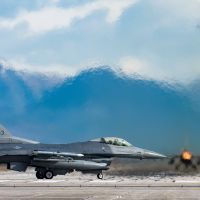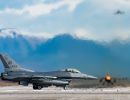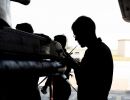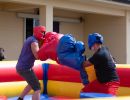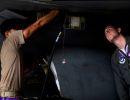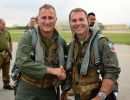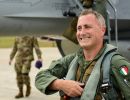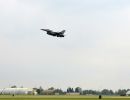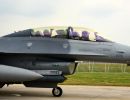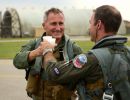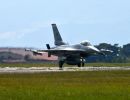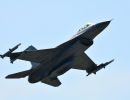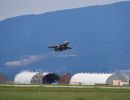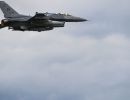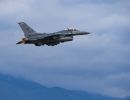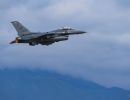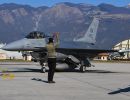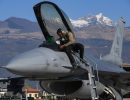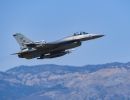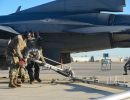The deployment featured two of the world's best fighters -- the F-16 Fighting Falcon and MiG 29 Fulcrum -- pitted against each other in "dissimilar" air-to-air combat tactics.
The meeting's significance, 510th pilots said, was heightened by the reality that, prior to the iron curtain's collapse, a "real-world" east-west confrontation almost certainly would have seen the two fighters clash in the skies above central Europe. Along with the reunification of Germany, former East German pilots were absorbed into the country's 73rd Fighter Group, bringing with them American fighter pilots' greatest threat, the former Soviet bloc's MiG 29s. And for 510th personnel, whether in the sky or on the ground, the experience was as unbelievable as it was unforgettable.
"Just a few years ago, it was unfathomable that we would have this kind of opportunity," said pilot Maj. John Nunnally. "As you walked out on the ramp at Deci and saw MiG 29s on one end and Italian F-104s, German F-4s and our F-16s on the other, it was an incredible sight."
According to Maj. David Pearce, maintenance officer, the ACMI range's hi-tech electronic telemetry system allows realistic training against realistic threats.
"On the ground, we could see and assess what was going on in the air-to-air engagements in real time." Pearce said the dogfight action took place in a multitude of scenarios: 4v4s (four F-16s versus four MiGs), 2v2s, 2v1s and others.
As to going head to head with the MiG, Aviano pilots said the highly-acclaimed, fourth-generation Russian fighter performed as advertised.
"It's an exceptional airplane," Nunnally said. "It performs very, very well. It met most of my expectations about the airframe."
"It was exhilarating because you go through the training with all the intelligence and so forth, and you figure out how you'll be able to identify him in the air," the major said. "Then, as you start your first fight, you look out there and see it really is a MiG."
For some 510th flyers, getting familiar with the Fulcrum went a step further -- flying it -- as did Capt. Mike McCoy who enjoyed some stick time in a two-seat version, putting the jet through F-16-type maneuvers.
"It (the flight) answered so many questions pilots had about the Fulcrum's unknowns -- how it maneuvers, what to expect in a dogfight, especially up close in what we call 'phone booth' fighting," McCoy said. "What really impressed me was the MiG 29's maneuverability at slower airspeeds. They have a lot of energy, but the F-16's a real nice jet, too, with lots of power -- we were able to outpower the MiGs, which makes me real happy."
McCoy said he felt the MiG's greatest strength is its thrust (the plane has two engines to the F-16's one), Archer heat-seeking air-to-air missile system and helmet-mounted weapons sight.
"With that helmet sight, they were able to take shots that you'd never expect a western-type jet to be able to take," the captain said. "That was pretty eye-opening."
Its drawbacks? Ergonomics and avionics, McCoy said.
"The limited visibility and cockpit ergonomics were way out there compared to what we're used to," he said. "It seems like it would take a long time to be able to find out where all the switches are. It takes a lot of effort, and you can get cockpit saturated very easily in the MiG 29."
And German MiG pilots' view of the F-16?
"Of the 12 (German pilots) who flew back seat with us, every one of them loved the automation," McCoy said. "Also , they really liked our HUD (heads up display) -- especially our ability to change switches and combat modes on the stick and throttle. They have to flick air engagement switches all over the cockpit, where we do everything with our hands on the stick and throttle."
The pilots were quick to credit those they say helped make the unique training experience a success.
"We can be proud of the way our maintainers prepared us, prepped our jets and launched us, the way our controllers handled the GCI (guidance and control intercept) work, all the way up the chain," Nunnally said.
Pearce said the numbers showed how effectively maintainers and support personnel paved the way for a successful deployment. During the three-week deployment, the 510th deployed 10 aircraft, flew more than 330 sorties and maintained a nearly 92 percent mission capable rate. The scheduling effectiveness rate hit nearly 99 percent, while pilots enjoyed 100 percent reliability rates for both guns and bomb releases during air-to-ground training that accounted for 20 percent of the deployment's total sorties. Of the 126 deployed, 88 were comprised of flighline maintaince personnel as well as select individuals from the maintenance and contracting squadrons.
"The former East Germans were awed by the quality of our aircraft as well as esprit de corps of our entire unit," Pearce said.
"Overall, we as a squadron had great successes and some disappointing failures," Nunnally said, "but overall, we learned a tremendous amount and have every right to be proud of ourselves as a fighting force and in the way we train. Overall, it was an incredible learning experience for us. The German pilots were absolutely exceptional as professional pilots and aviators. We also made some great and lasting friendships."

 More than 120 members of the 510th Fighter Squadron returned home May 26 following a three-week training deployment to Decimomannu, Sardinia, where they slugged it out with their German counterparts in "friendly" competition at the Air Combat Maneuvering Instrumentation Range.
More than 120 members of the 510th Fighter Squadron returned home May 26 following a three-week training deployment to Decimomannu, Sardinia, where they slugged it out with their German counterparts in "friendly" competition at the Air Combat Maneuvering Instrumentation Range.
